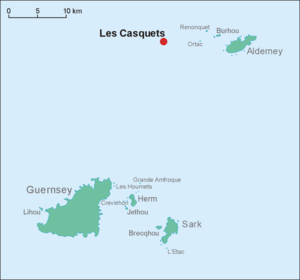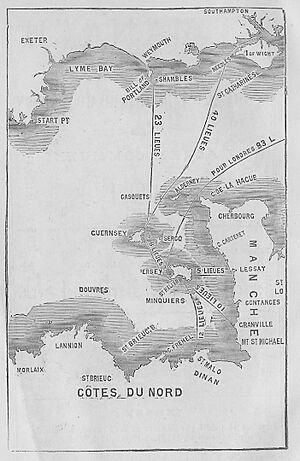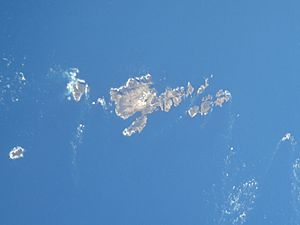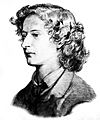Casquets facts for kids
Les Casquets (also called The Casquets) is a group of rocks located about 13 kilometers (8 miles) northwest of Alderney. These rocks are part of an underwater ridge made of sandstone. Other parts of this ridge that stick out of the water include the small islands of Burhou and Ortac. Not much grows on Les Casquets because of the harsh conditions.
Contents
What Does "Casquets" Mean?
People have different ideas about where the name "Casquets" comes from:
- Some think it comes from the French word 'cascade', which means waterfall. This makes sense because of the strong tidal surges (fast-moving water) that flow around the rocks.
- Another idea is that it comes from 'casque', which is French for helmet. This could be because the rocks look a bit like helmets.
- A third idea is that it comes from two French words: 'cas' (broken) and 'quet' (rock). So, "broken rocks."
An old map from around 1640 called the rocks Casus Rupes, which is Latin for "broken rocks." This might support the third idea, but it could also be a folk etymology (a made-up story about where a word comes from).
History of Les Casquets
Shipwrecks Near Les Casquets
Many ships have been wrecked on the Casquets rocks over the years. The strong tides in this area can reach speeds of 6-7 knots (very fast!), and there aren't many clear landmarks, which made it hard for ships to navigate safely.
One famous shipwreck was the SS Stella, which sank in 1899. The largest ship to wreck here was the 8,000-tonne water tanker Constantia S.
For a long time, people thought that the famous British warship HMS Victory sank near the Casquets in 1744. The lighthouse keeper on Alderney was even put on trial for supposedly not keeping the light on when the ship was lost. However, when the wreck of HMS Victory was finally found in 2008, it was over 110 kilometers (60 nautical miles) away from the Casquets!
The Casquets Lighthouses
The first lighthouses on Les Casquets began working on October 30, 1724. There were three towers, named St Peter, St Thomas, and the Dungeon. They were lit by coal fires. Three stone towers were built so that their lights wouldn't be confused with lights from nearby France.
These lighthouses were built by Thomas Le Cocq, who owned the rocks. He had permission from Trinity House (the official lighthouse authority in England). He was paid a small fee for every ton of ship that passed the rocks, and he paid Trinity House £50 a year. In 1785, Trinity House took over running the lighthouses completely.
The lights were improved on November 25, 1790, when they were changed to oil lamps with metal reflectors. In 1818, they were upgraded again with a system that could rotate a beam of light. This system had a clockwork mechanism that needed to be wound up every hour and a half, and it made one flash every 15 seconds.
A very bad storm on October 31, 1823, badly damaged the lighthouses and smashed their lanterns. The towers were made taller by another 9.1 meters (10 yards) in 1854. Powerful 184 kilocandela lamps were added, which gave three slow flashes every half minute. In 1877, the North West Tower was made even taller, and the lights in the other two towers were turned off.
During the Second World War, after the German occupation of the Channel Islands in 1940, British commandos from the Small Scale Raiding Force carried out two raids on the lighthouse. In the first raid, called Operation Dryad, on September 2-3, 1942, the seven lighthouse keepers were taken back to England as prisoners of war.
In 1954, the lighthouse was changed to use electricity, and a very bright 2,830 kilocandela lamp was installed. This lamp is special because it rotates counter-clockwise (the opposite way a clock's hands turn). At the same time, the other two towers were made shorter.
Today, the light in the 23-meter (75-foot) North West Tower is 37 meters (121 feet) above the average sea level. It flashes five times every 30 seconds, with each flash 3.7 seconds apart. On a clear day, you can see it from about 44 kilometers (24 nautical miles) away.
The East Tower holds the foghorn, which makes two loud blasts every 60 seconds. This sound can be heard up to 5.6 kilometers (3 nautical miles) away. The South West Tower has a helipad (a landing spot for helicopters) on top, and there's another helipad on a flat part of the rock. The rocks also use a racon (a special radar beacon) that shows a Morse letter T on radar displays.
The lighthouse complex became automated in 1990, meaning no one lives there anymore. It is now watched and controlled from the Trinity House Operations Control Centre in Harwich.
- Channel Islets - Victor Coysh
Images for kids
See also
 In Spanish: Casquets para niños
In Spanish: Casquets para niños








